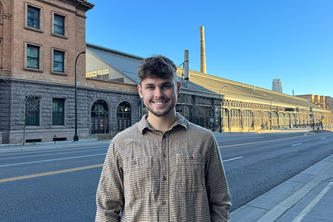
MINNEAPOLIS/ST. PAUL (06/14/2023) — University of Minnesota researchers developed a highly sophisticated model to assess lactating cow heat stress, a problem that can lead to numerous health complications for cows and financial difficulties for dairy producers due to reduced milk production and pregnancy rates.
Though several empirical equations have been developed to identify heat stress conditions, the new model is the most comprehensive available. It was recently detailed in two papers in the journal of the American Society of Agricultural and Biological Engineers — the first paper describes the equations and cow characteristics used in the modified model, and the second paper compares model results with data from cows experiencing heat stress and unpublished data from solar panel shade work done at the West Central Research and Outreach Center in Morris, Minnesota.
The research team modified a steady-state heat transfer model developed by McGovern and Bruce (2000) by incorporating work from other researchers, two new empirical relations for cow characteristics and a new solution procedure.
The modified model describes heat exchange between a lactating cow and the environment through respiration, air flowing past the cow, sweating and shortwave and longwave radiation. The model can be used to assess the impact of body mass, milk yield, solar load, air temperature, dew-point temperature, and air velocity on heat exchange rates, cow respiration rate and body temperature.
They found:
- The process-based model results compare well with the published respiration rates and body temperatures of heat stressed lactating cows.
- The model results were commonly within one standard deviation of the reported averages.
- The thermal balance model can be used to identify key heat stress factors and assess mitigation practices.
“Process-based models provide a better understanding of how cows exchange heat with the environment than empirical equations. Engineers will be able to use the model to better assess alternative cooling designs,” said Kevin Janni, a professor in the Department of Bioproducts and Biosystems Engineering and an Extension engineer.
Creating better cooling designs could help reduce heat stress related health conditions, which include lower milk production and pregnancy rates, increased disease and death rates, calves with lower birth weights, and impaired immune function.
Looking ahead, the researchers plan to use the modified model to assess alternative cow cooling designs and the trade off associated with the costs for ventilating fans, cooling fans, evaporative cooling systems versus the reduced heat stress on lactating cows.
About the College of Food, Agricultural and Natural Resource Sciences
The University of Minnesota’s College of Food, Agricultural and Natural Resource Sciences (CFANS) strives to inspire minds, nourish people, and sustainably enhance the natural environment. CFANS has a legacy of innovation, bringing discoveries to life through science and educating the next generation of leaders. Every day, students, faculty, and researchers use science to address the grand challenges of the world today and in the future. CFANS offers an unparalleled expanse of experiential learning opportunities for students and the community, with 12 academic departments, 10 research and outreach centers across the state, the Minnesota Landscape Arboretum, the Bell Museum of Natural History, and dozens of interdisciplinary centers. Learn more at cfans.umn.edu.
- Categories:
- Agriculture and Environment
- Animals





